Italian industrial production fell back at the fastest rate in nearly a year in September as a stronger euro is making Italian exports more less competitive with products from outside the eurozone and as consumer spending continues to follow its lacklustre path. In fact this was the first fall in three months, as up to September Italian industrial output, and really somewhat against the trend, had been holding up rather well.

Production fell 1 percent from the previous month, when it rose a revised 1 percent, according to data from the national statistics institute - Istat,
released at the end of last week.
According to Luca Cordero di Montezemolo, chairman of Fiat SpA, Ferrari SpA and head of Italy's Confindustria ``The strong euro is creating enormous problems....When a company like Ferrari exports 30 to 35 percent of production to the dollar area, it's hard for us.''
Concern about the strength of the rising value of the euro, which climbed to a record of $1.4738 on Friday, has also help drag Italian business confidence to its
lowest level in almost two years in October. In addition oil prices moving in the direction of the $100 a barrel range are raising manufacturing costs and leaving households with less money to spend.
The European Central Bank left the benchmark interest rate unchanged last week as policy makers weighed signs of slowing economic growth in countries like Germany and Italy against the threat of accelerating inflation.
Manufacturing in France and Germany, Italy's two biggest trading partners,is also slowing. French production dropped 1.1 percent on August while German output growth slowed to 0.3 percent from August when it surged 1.9 percent.
Italian production of consumer goods declined 4.2 percent in the month. Manufacturing of non-durable goods such as clothing declined 4 percent. Durable goods, which include washing machines and refrigerators, fell 3.7 percent.
The declines in production of consumer-related goods reflect Italian households' reluctance to spend, and indeed Italian retail sales
fell for an eighth month in October.
The Italian government last month cut its economic growth forecasts to an expansion of 1.9 percent this year, slowing to 1.5 percent in 2008, as rising credit costs triggered by the collapse of the U.S. subprime mortgage market damp the global expansion.

















